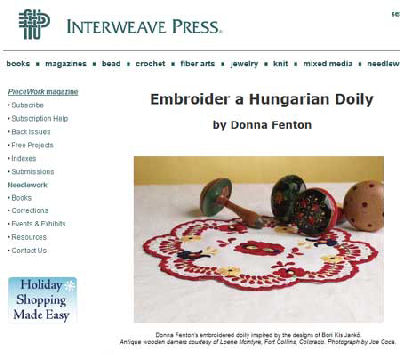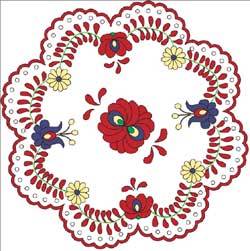If you’re familiar with Piecework magazine, you may already be aware of this pattern. It’s really beautiful!
Piecework magazine is a needlework magazine published by Interweave Press. On their website, they have a bunch of articles archived, and if you take the time to browse them, you’ll probably come up with some real gems to add to your own “to do” list!
This particular project is a Hungarian Doily – a brightly colored embroidered piece that’s really lovely! Talk about a great Christmas present!
If you click on the picture below, you’ll go to the original article, with the detailed instructions for this Hungarian Doily. I would say that the project is suitable for intermediate level embroiderers, or perhaps even for determined beginners! The instructions are clear, but they assume some knowledge of surface embroidery.

The design is quite bold – very striking and colorful, typical of Hungarian embroidery. If you click on the photo below, you’ll go straight to the PDF file of the design itself. The instructions (including directions on embroidery stitches) are found in the original article.

Besides using the design as a doily, you could adapt it to a table runner (nice colors for Christmas!) or to the corners of a table cloth or even the edges of a pillow case! With a little creativity, there are plenty of options!

I took the design and skewed it a bit to even up the scallops, then worked up a scallop repeat, to show you how you could play with it. However, I kept it small, because certainly, the original image isn’t mine to alter and pass on. If you want to alter it for your own personal use, though, you can get an idea of possibilities.
Have fun with it!







Mary, I really enjoy your site–and you’ve inspired me to start embroidering. . .so much more fun than cross-stitch!
I am planning to make this doily, but the only question I have is what fabric to use. The instructions say, “100% cotton, medium-weight”–but that seems kind of vague. I bought some ‘trigger’ cloth to practice on, but it is difficult to get the satin stitching to look nice–though it seems a good weight for a doily.
Am I just inexperienced, or could you recommend a particular fabric? (I’m using perle cotton size 8 as instructed). I would love to see a discussion on your site about matching fibers to fabric (maybe it’s too big a topic.)
Hi, Beth!
Actually, it’s not too big a topic – I think it’s a good idea to discuss fibers and fabrics for embroidery! After all, it’s the most pertinent thing when it comes to embroidery, isn’t it?
I wouldn’t use trigger cloth – it’s not “smooth” enough. I’d look for a good high-count cotton muslin (like Southern Belle). If you have a quilt shop nearby, they may carry it. You could also use a nice crisp Egyptian “shirting” cotton, but I think you’d have to find that at a pretty good fabric store. Chain stores don’t always carry ‘nice’ cottons (though it doesn’t hurt to ask!)
I’ve ordered Southern Belle from Carriage House quilt shop online before. Their price per yard and shipping is very reasonable.
Here’s a link:
Carriage House Quilt Shoppe – Southern Belle Muslin
Hope that’s helpful! Good luck on it – let us know how it goes!
PS – with a “firmly woven” cotton, make sure you’re using the right needle! A number 8 perle will require a larger needle. The needle should thread easily and it should be about the same size as the thread…. (too fine a needle would be really hard to work with!)
Thanks, that’s very helpful information! The instructions ask for a Sharp size 3 needle, so that’s what I’ve been using (thanks to Twining Thread, I now own a gazillion needles–they came in my treasure box). It’s a little hard to thread, but seems about right otherwise. Does the brand matter (beyond cheap vs. respectable)? They ask for a John James, and I have Richard Hemming.
p.s. can I use stretcher bars instead of a hoop?
Hi, Beth – Richard Hemming needles are good. No problem there!
You sure can use stretcher bars, and I’ll bet you’ll like it better that you are using them rather than a hoop – the tension is better and requires less adjustment!
Make sure your stretcher bars are at least two inches all around bigger than the finished dimension of the project, and make sure you cut your fabric at least two inches (or three) bigger than the assembled dimensions of your stretcher bars!
Do let us know how it goes! I’d love to see a photo when you finish it, or even as you progress!
Good luck!
Just for the sake of reference… my Hungarian grandmother never used a stretcher or hoop; she claimed it pulled the work out of square (my engineer father's translation). She taught me to embroider without one. Hold the point of work reasonably (but not overly) taut between the fingers of your non-needle hand. This means you won't use stitches that are too big. Guide the needle straight and true. It will come out right. Block your work.
I loved reading your article on this and thank you very much for the link! I learned how to do this typed of embroidery when I was 8 years old on vacation with my Grandmother in Hungary. The lady that taught me was my Grandmothers best friend and has since passed away. At 26 years old, I have decided I need to pick this back up and I absolutely love it! One thing to add, none of the ladies I knew then and know now that do this have ever used a stretcher or a hoop. Like an earlier commenter said, it pulls the work and can damage it. Thanks again so very much for this link! Do you know where else you can get patterns for this type? I am having a lot of trouble finding them and I am having to put blouses, aprons, skirts and doilies on a copier to get a pattern!!!
Hi, Kristen – Thanks for your comment! I think it’s great that you’re picking up this kind of needlework again. I love the design on this piece! I don’t know where to find other patterns, but you’re lucky to have pieces that you can copy and convert into patterns. That’s a good way to get authentic designs! Your best bet might be to look up shops actually in Hungary to see if you can find anything there that’s available. Sorry I can’t help you further with a resource, but I’ll certainly keep my eye out and if I come across anything, I’ll post it on the site! ~MC